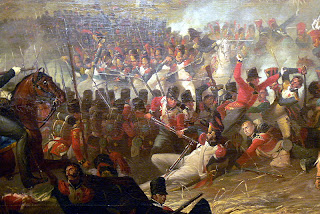OK, I’m cheating a bit because despite having power all through the storm I spent it lounging around blissfully reading and baking and eating the products of the baking. Now everything has caught up with me, so I’m recycling a post in which I talk about the city of Bath and my late aunts Phyl and Nell who introduced me to Heyer and who shared my love of reading and Austen.

They were born about a century ago in London, the older sisters of my father. Their parents were of Irish descent, their mother (my g-grandmother) was in service according to the 1901, census and their father a maker of brass musical instruments. Neither of my aunts married. They shared houses and when I was a child we visited them in their wonderful house in Bath, on Lansdown Place West. This may be their house, I can’t read the house number.
Lansdown Place West is the continuation of Lansdown Crescent, one of the most beautiful pieces of Georgian architecture in the city, constructed between 1789 and 1793 and designed by architect John Palmer. It’s higher than the more famous Royal Crescent, with an amazing view of the city.
In front of Lansdown Crescent is a field still used for grazing, one of the original design features of the Royal Crescent (and possibly other places too)–the idea being that you’d have the pleasures of the town with the healthful idyll of country life.
 The only (so far as I know) famous, or infamous, occupant of Lansdown Crescent was William Beckford who lived at number 19 and 20 (the ones with the imposing frontage). The houses have four floors, servants’ quarters in the basement, and mews behind the Crescent.
The only (so far as I know) famous, or infamous, occupant of Lansdown Crescent was William Beckford who lived at number 19 and 20 (the ones with the imposing frontage). The houses have four floors, servants’ quarters in the basement, and mews behind the Crescent.
My aunts showed me the city of Bath. They took me to tea at the Pump Room and Sally Lunn’s, boat rides on the river, tours of the Roman Baths, and walks around the city. There was a shop, now moved to a different location in the Guildhall, Gillards of Bath, which was very little changed from Victorian times. Loose tea, stored in massive metal containers, was measured on scales, tipped onto a sheet of brown paper, and folded into a miraculous neat cube, tied with string.
 Their house on Lansdown Place West became too much for them–all those stairs and continual maintenance, so they moved to an early eighteenth-century house in Batheaston (lots of stairs and continual maintenance) a few miles east of the city. Again, this may or may not be their house but it’s very close!
Their house on Lansdown Place West became too much for them–all those stairs and continual maintenance, so they moved to an early eighteenth-century house in Batheaston (lots of stairs and continual maintenance) a few miles east of the city. Again, this may or may not be their house but it’s very close!
My aunts loved Heyer, Austen and Georgian/Regency architecture, fashions, and furniture long before they became popular, and picked up antiques for a song at jumble sales. They taught me it’s possible to fall in love with a place and I certainly fell in love with Bath, thanks to them. They even suggested I write, although at the time I thought it was a weird idea. A few years ago I met with a psychic who told me she saw them behind my shoulder and they were both very proud of my writing, although Nell (it must have been Nell!) was quite upset at what I’d done to Jane Austen (not to mention the sex!)
I’m so grateful for what they gave me.
Who were your mentors for writing or any other passion? And have you ever had a session with a psychic that unearthed something interesting?

.jpg)





